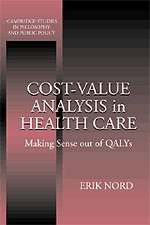Crossref Citations
This Book has been
cited by the following publications. This list is generated based on data provided by Crossref.
Stigum, Hein
Magnus, Per
Samdal, Helvi Holm
and
Nord, Erik
2000.
Human T-cell lymphotropic virus testing of blood donors in Norway: a cost-effect model.
International Journal of Epidemiology,
Vol. 29,
Issue. 6,
p.
1076.
Green, Colin
2001.
On the societal value of health care: what do we know about the person trade‐off technique?.
Health Economics,
Vol. 10,
Issue. 3,
p.
233.
Nord, Erik
2001.
Severity of illness versus expected benefit in societal evaluation of healthcare interventions.
Expert Review of Pharmacoeconomics & Outcomes Research,
Vol. 1,
Issue. 1,
p.
85.
Nord, Erik
2001.
The desirability of a condition versus the well being and worth of a person.
Health Economics,
Vol. 10,
Issue. 7,
p.
579.
Sintonen, Harri
2001.
The 15D instrument of health-related quality of life: properties and applications.
Annals of Medicine,
Vol. 33,
Issue. 5,
p.
328.
Cuadras‐Morató, Xavier
Pinto‐Prades, José‐Luis
and
Abellán‐Perpiñán, José‐María
2001.
Equity considerations in health care: the relevance of claims.
Health Economics,
Vol. 10,
Issue. 3,
p.
187.
Schwappach, David L. B.
2002.
Resource allocation, social values and the QALY: a review of the debate and empirical evidence.
Health Expectations,
Vol. 5,
Issue. 3,
p.
210.
Commission, Productivity
2002.
Health Policy Roundtable.
SSRN Electronic Journal,
Höjgård, S.
Enemark, U.
Lyttkens, C. H.
Lindgren, A.
Troëng, T.
and
Weibull, H.
2002.
Discounting and clinical decision making: Physicians, patients, the general public, and the management of asymptomatic abdominal aortic aneurysms.
Health Economics,
Vol. 11,
Issue. 4,
p.
355.
Hofstetter, Patrick
and
Hammitt, James K.
2002.
Selecting Human Health Metrics for Environmental Decision‐Support Tools.
Risk Analysis,
Vol. 22,
Issue. 5,
p.
965.
Bryan, Stirling
Roberts, Tracy
Heginbotham, Chris
and
McCallum, Alison
2002.
QALY‐maximisation and public preferences: results from a general population survey.
Health Economics,
Vol. 11,
Issue. 8,
p.
679.
Brinsmead, R.
and
Hill, S.
2003.
Use of pharmacoeconomics in prescribing research. Part 4: is cost-utility analysis a useful tool?.
Journal of Clinical Pharmacy and Therapeutics,
Vol. 28,
Issue. 4,
p.
339.
Adler, Matthew D.
2003.
Fear Assessment: Cost-Benefit Analysis and the Pricing of Fear and Anxiety.
SSRN Electronic Journal ,
Schwappach, David L.B.
2003.
Does it matter who you are or what you gain? an experimental study of preferences for resource allocation.
Health Economics,
Vol. 12,
Issue. 4,
p.
255.
Hoel, Michael
2003.
Allocating health care resources when people are risk averse with respect to life time.
Health Economics,
Vol. 12,
Issue. 7,
p.
601.
Brock, Dan
2004.
Handbook of Bioethics.
p.
353.
Oliver, Adam
2004.
Prioritizing Health Care: Is “Health” Always an Appropriate Maximand?.
Medical Decision Making,
Vol. 24,
Issue. 3,
p.
272.
Richardson, Jeff
Atherton Day, Neil
Peacock, Stuart
and
Iezzi, Angelo
2004.
Measurement of the Quality of Life for Economic Evaluation and the Assessment of Quality of Life (AQoL) Mark 2 Instrument.
Australian Economic Review,
Vol. 37,
Issue. 1,
p.
62.
Hornbrook, Mark C.
2004.
Outcomes Assessment in Cancer.
p.
480.
Prieto, Luis
and
Sacristán, José A
2004.
What is the value of social values? The uselessness of assessing health-related quality of life through preference measures.
BMC Medical Research Methodology,
Vol. 4,
Issue. 1,



